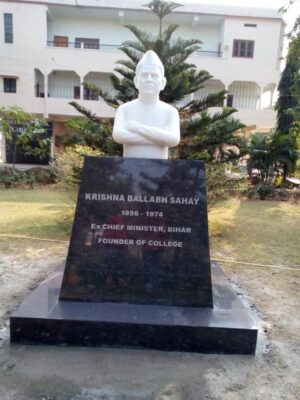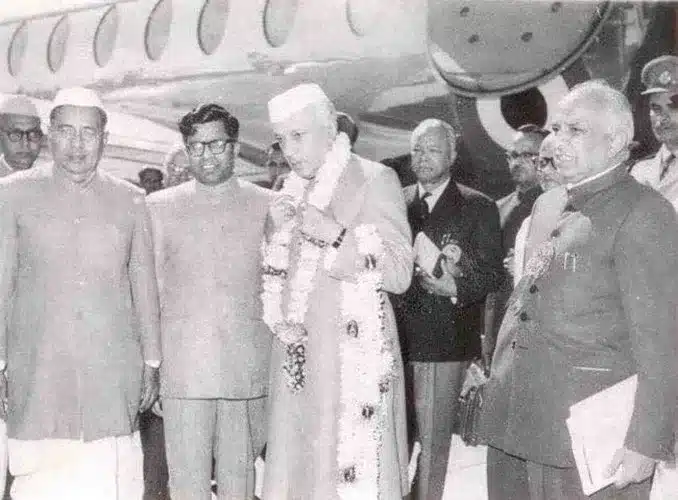Jawahar Lal Nehru with Krishna Ballabh Sahay | Image Source: Facebook/Krishna Ballabh Sahay
Krishna Ballabh Sahay (31 December 1898 – 3 June 1974) was an Indian freedom fighter who became the Revenue Minister of Bihar after independence and then the third Chief Minister of unified Bihar. Krishna Ballabh Sahay popularly known as K. B. Sahay.
Early life
Krishna Ballabh Sahay was born in 1898 in Sheikhpura, Gaya district, Bihar, to an Ambashtha Kayastha family. The eldest son of Munshi Ganga Prasad, who served as a Darogha under British rule in Padma. In 1919, he graduated with first class in B.A. Hons. English from St. Columba’s College, Hazaribagh.
Political and Public life
Sri Krishna Ballabh Sahay joined Mahatma Gandhi’s Civil Disobedience Movement after giving up further studies shortly after. During the independence movement, he was jailed four times between 1930 and 1934. During one of these arrests, he met his mentor Sri Krishna Sinha, and that friendship lasted their whole lives. He was also close to Anugrah Narayan Sinha, another legendary nationalist from Bihar.
Gandhi’s “Do or Die” battle cry for the Quit India movement came in 1942. Earlier, senior leaders of Bihar including Dr. Rajendra Prasad and Dr. Anugrah Narayan Sinha met at Sadaquat Ashram to discuss the “Vardha Accord” and to map out an action plan for Bihar during the Quit India Movement. Sri Krishna Ballabh Sahay made a big contribution to this plan. K B Sahay led the movement at Hazaribagh with great ferocity.
The British government ordered all its leaders arrested immediately. The Deputy Commissioner of Hazaribagh ordered K B Sahay arrested
In jail, he helped Jayaprakash Narayan escape with his friends Rama Nandan Mishra, Yogendra Shukla, Suraj Narayan Singh, Sri Gulab Chand Gupta and Sri Shaligram Singh on 9 November 1942. Because of that, he got sent to Bhagalpur jail for strict punishment.
Sri K B Sahay was elected to the Bihar Legislative Assembly in 1936 when the British Raj granted provinces autonomy. In 1937, he became a parliamentary secretary in Sri Krishna Sinha’s ministry.
Abolition of Abolition of Zamindari
During this period, K. B. Sahay also developed sympathy for the poor peasants whose inhuman suffering at the hands of zamindars had a profound bearing on his mind. During a meeting at Chhapra on 11 May 1942, presided over by Dr. Rajendra Prasad, and another at Kudra in Shahabad, he talked a lot about it.
Anugrah Babu, Deputy Chief Minister of Bihar, and Sri Babu, Chief Minister of Bihar, both came from zamindar families. Sri Babu told him to hold a public meeting in his hometown, Tarapur, in Munger. Sri Babu and Krishna Ballabh Babu talked about the “Torture of inhabitants by their Zamindar” at this meeting. The meeting was attended by Acharya J. B. Kriplani and was a big success.
In Bihar, after independence, K.B. Sahay got the Revenue ministry since it was his favorite subject. He was able to fulfill his long-cherished dream of freeing the peasants from the clutches of the zamindars. K. B. Sahay was assisted suitably by Sri Bajrang Sahay in drafting the “Abolition of Zamindari” Bill and the credit for its successful implementation belongs to Sri Krishna Babu who faced the brunt of the zamindars in the Bihar Assembly and got it passed successfully.
He wrote and passed the first law abolishing the Zamindari system in the country. It was the first of its kind in the country. It sent shockwaves among the zamindars all over Bihar when the law became a law (Bihar Act 30 of 1950), and they decided to challenge the law as a violation of Article 14 of the Constitution.
Sri K. B. Sahay also survived a body blow that was meant to kill him. K.B. Sahay was almost alone in his crusade for land reforms in the formative 1950s and ’60s. Bihar was the first state to abolish Zamindari. Patna High Court and Supreme Court both struck down the Act. Jawaharlal Nehru was so frustrated he pushed for the first amendment. For the first time, the Constitution of India was amended, and Article 31 (A) and Article 31 (B) were added to nullify the effect of Article 14. In 1955, the legislation on land ceilings was introduced in the Assembly. A watered-down version got presidential approval only in 1959.
B. Sahay contested the first assembly elections of 1952 from Giridih and won by a handsome margin. In Sri Babu’s cabinet, he returned as the revenue minister. In 1957, he lost to Raja Kamakhya Narayan Singh of Padma (Hazaribag) in the assembly election from Giridih. Meanwhile, K. B. Sahay won the 1962 assembly elections to get into the Bihar Assembly for the third time. During the leadership struggle between Dr. S K Sinha and Dr. Anugrah Narayan Sinha, he backed Anugrah Babu to become Chief Minister. Sri Krishna Babu won and became the CM again with Anugrah Babu as his deputy.
Award Recognition and Legacy
His statue inside a large triangular park can be seen by all commuters to Hazaribagh from the Highway itself. In 1963, he helped start a women’s college in Hazaribag, which was named for him.
He supported the establishment of Sainik School in Tilaiya when he was Bihar’s Chief Minister. Krishna Ballabh Sahay set up several industries in the state, including the Bokaro Steel Plant and Barauni Refinery. Both were commissioned while he was Chief Minister. Ranchi Heavy Engineering Corporation was also established during his tenure.

Assassination
Krishna Ballabh Sahay was assassinated on 3 June 1974 on the Hazaribag – Patna Highway in Sindoor because of a truck and his Hindustan Ambassador clash. He’s said to have been assassinated by criminalized sections of the Indian National Congress who were against his rise in Bihar politics and his calls for Zamindari abolition.

